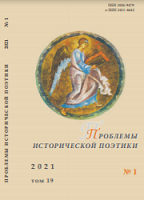Церковный календарь, евангельский и литургический текст в романе «Подросток» и «Дневнике Писателя» (1876) Ф. М. Достоевского
Church Calendar, Gospel and Liturgical Text in the Novel The Raw Youth and A Writer’s Diary (1876) by Fyodor Dostoevsky
Author(s): Elena A. FedorovaSubject(s): Christian Theology and Religion, Studies of Literature, Russian Literature, 19th Century
Published by: Петрозаводский государственный университет
Keywords: F. M. Dostoevsky; historiosophy; the Gospel; Holy Scripture; church calendar; plot; motive; precedent text;
Summary/Abstract: F. M. Dostoevsky’s novel The Raw Youth (1874–1875) and A Writer’s Diary (1876) were created in the tradition of Christian calendar prose, which is aligned with sacred time. The two works are united by the idea of the religious transformation of personality, the salvation of the soul and unification around the Gospel Truth, the search for ideal foundations in the Russian people, and reflections on their purpose. Dostoevsky introduces Easter narratives into the novel and into A Writer’s Diary in 1876: the story of Makar Dolgoruky about the merchant Skotoboinikov, the opera by Trishatov, the story The Peasant Marey. The plot and storyline motives of these works and the novel go back to the parable of the Prodigal Son and the Book of Job. They share the motives of suffering, redemption and resurrection. A Writer’s Diary of 1876, which utilizes a system of references to the novel, starts from January and contains a reference to the celebration of the Nativity (the Christmas story The Beggar Boy at Christ’s Christmas Tree, quotes from a Christmas worship service), and ends in December, at the beginning of advent. A Writer’s Diary contains an appeal to Christmas and Easter as the most significant dates of the church calendar and the writer’s personal biographical time. In the chapter More on a Simple but Tricky Case (December), Dostoevsky recalls how he survived the December 22 execution on the Semyonovsky parade ground and a revival on Christmas Eve; in the Easter story The Peasant Marey (February), he tells the story of how he acquired faith in the Russian people in penal servitude during Easter. The author’s position in the novel The Raw Youth and A Writer’s Diary of 1876 can’t be comprehended without referring to the gospel and liturgical text. The Gospel parable of the Prodigal Son and the Book of Job, which are referenced in the novel and A Writer’s Diary, are read in church before and during Great Lent.
Journal: Проблемы исторической поэтики
- Issue Year: 19/2021
- Issue No: 1
- Page Range: 258-282
- Page Count: 25
- Language: Russian

